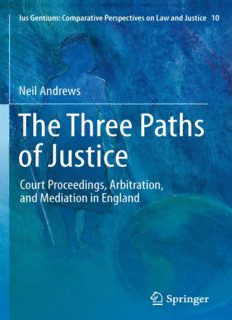
The Three Paths of Justice: Court Proceedings, Arbitration, and Mediation in England PDF
Preview The Three Paths of Justice: Court Proceedings, Arbitration, and Mediation in England
THE THREE PATHS OF JUSTICE IUS GENTIUM COMPARATIVE PERSPECTIVES ON LAW AND JUSTICE VOLUME 10 Series Editors MortimerSellers (UniversityofBaltimore) JamesMaxeiner (UniversityofBaltimore) Board of Editors MyroslavaAntonovych(Kyiv-MohylaAcademy) NadiadeAraujo(PontificalCatholicUniversityofRiodeJaneiro) JasnaBakšic´-Muftic´ (UniversityofSarajevo) DavidL.CareyMiller(UniversityofAberdeen) LoussiaP.MusseFelix(UniversityofBrasília) EmanuelGross(UniversityofHaifa) JamesE.HickeyJr.(HofstraUniversity) JanKlabbers(UniversityofHelsinki) ClaudiaLimaMarques(FederalUniversityofRioGrandedoSul) AnicetoMasferrer(UniversityofValencia) EricMillard(Paris-SudUniversity) GabriëlMoens(MurdochUniversity,Australia) RaulC.Pangalangan(TheUniversityofthePhilippines) RicardoLeitePinto(LusíadaUniversityofLisbon) MizanurRahman(UniversityofDhaka) KeitaSato(ChuoUniversity) PoonamSaxena(UniversityofNewDelhi) GerrySimpson(LondonSchoolofEconomics) EduardSomers(UniversityofGhent) XinqiangSun(ShandongUniversity) TadeuszTomaszewski(UniversityofWarsaw) JaapW.deZwaan(NetherlandsInst.ofIntrntl.Relations,Clingendael) THE THREE PATHS OF JUSTICE COURT PROCEEDINGS, ARBITRATION, AND MEDIATION IN ENGLAND by Neil Andrews 123 NeilAndrews ClareCollege TrinityLane CB21TLCambridge UnitedKingdom [email protected] ISBN978-94-007-2293-4 e-ISBN978-94-007-2294-1 DOI10.1007/978-94-007-2294-1 SpringerDordrechtHeidelbergLondonNewYork LibraryofCongressControlNumber:2011936162 ©SpringerScience+BusinessMediaB.V.2012 Nopartofthisworkmaybereproduced,storedinaretrievalsystem,ortransmittedinany form or by any means, electronic, mechanical, photocopying, microfilming, recording or otherwise,withoutwrittenpermissionfromthePublisher,withtheexceptionofanymaterial suppliedspecificallyforthepurposeofbeingenteredandexecutedonacomputersystem,for exclusiveusebythepurchaserofthework. Printedonacid-freepaper SpringerispartofSpringerScience+BusinessMedia(www.springer.com) ForLiz,Sam,Hannah,andRuby andinmemoryof KurtLipstein 1909–2006 ProfessorofComparativeLaw,Universityof Cambridge, FellowofClareCollege, BencherofMiddleTemple ThisisBlankPageIntegra vi Foreword In this book Neil Andrews does non-English lawyers a great service: he gives us an authoritative, digestible and—and at the same time—critical guide to the new civil justice in England and Wales. For a dozen years we havewatched—sometimes puzzled—as thequeen ofcommon lawsystems has transformed itself in ways that we have not seen heretofore and to an extentthatEnglandhasnotexperiencedforalongtime.Ledbythe‘Woolf reforms’ of 1999, the metamorphosis has included, in addition to substan- tialchangesincivilprocedure,theintroductionoftheHumanRightsActof 1998 (entered into force 2000), the establishment of a Ministry of Justice (2007) and the abolition of the House of Lords (Judicial) and creation of theSupremeCourtoftheUnitedKingdom(beganbusiness2009). Neil Andrews is one of England’s best known proceduralists and author of one of its best known treatises on civil procedure. He, as well as any- one could, guides readers through the thickets and hedges of England’s reforms to the essential elements of the reforms. He helps readers learn conveniently what is new and what is old: what is system-shaking and is thereforeespeciallyworthyofforeignattention. SuchaguideisparticularlyneededbyAmericanlawyersandlawreform- ers: Americans are accustomed to looking to England for ideas for the American system. Even before the Woolf reforms came into effect, some American observers ascribed a ‘Continental Character’ to English law dis- tinct from America’s common law. We all wonder what the effects of the predominantly civil law European Union will be on its premier common lawsystem. American lawyers need not fear English abandonment of values their system holds dear. The ‘overriding objective’ of the Woolf reforms is the enabling of courts ‘to deal with cases justly.’ Areas they target for reform include putting parties on an equal footing, dealing with cases proportion- ately to the disputes involved, and handling cases expeditiously and fairly. Neil Andrews, in Chap. 2 of the book, ‘Principles of Civil Justice,’ lays outfourheadingsunderwhichtoconsiderthefundamentalandimportant principlesofciviljustice: vii viii Foreword a. RegulatingAccesstoCourtandtoJustice b. Ensuring the Fairness of the Process: a Shared Responsibility of the CourtandtheParties c. MaintainingaSpeedyandEfficientProcess d. AchievingJustOutcomes These are not alien to American lawyers: they are at the heart of American civil justice. They are the promises that America’s founding fathers made in their declarations of rights of 1776.1 These are, indeed, valuessharedbycivillawsystems. IcommendNeilAndrewsforhisopenness.Hisworkisvaluablebecause heiscritical.Heisnottimid.HeisnotcontenttorecitethehopesofEnglish reformers;hedoesnotfinessehardproblemsbycallingthemoutofplacein ashortwork.Hedoesnotretreattoastudent’soutline.Insteadhesetsout therealitiesofthereforms’implementation.Hecallsfailureswhenhesees them: through colorful language he imprints them in readers’ memories. Igivebutoneexample: BillGateshimself,andothermodern-daydescendantofCroesus,wouldhesitate toruntheriskofengaginginprotractedandcomplicatedclaimshearbytheHigh Court.The‘Woolfreforms’of1999wereexpectedtoalleviatetheproblemofthe highcostsoflitigation.Butthesituationhasnotimproved.[9.16] Americans hoping to find in England a panacea for the failures of American civil justice will be disappointed. The ailments of English civil justice—above all lawyer control of proceedings—are largely our own. If we are to overcome them, we must be open to changes that differ from traditionalcommonlawapproaches. Baltimore,Maryland JamesR.Maxeiner 1They were included in what are called ‘open courts’ clauses. That in Maryland’s DeclarationofRightsofNovember3,1776reads: 17. That every freeman, for any injury done to him in his person, or property, ought to have remedy by the course of the law of the land, and ought to have justiceandright,freelywithoutsale,fullywithoutanydenial,andspeedilywithout delay,accordingtothelawoftheland. Maryland Declaration of Rights of Nov. 3, 1776, in The Decisive Blow is Struck, A facsimile edition of The Proceedings of the Constitution Convention of 1776 and the First Maryland Constitution (1977). Similar declarations were made throughout colo- nialAmerica.J.Maxeiner,G.Lee,andA.Weber,FailuresofAmericanCivilJusticein InternationalPerspective3–5(2011). Preface Thisworkisintendedtoenablelawyers,especiallynon-Englishlawyers,to gainanoverviewofthethreemainprocessesnowoperatinginEnglandfor theresolutionofcivildisputes:civilproceedingsinthecourts,arbitration, andmediation.Thesethreeformsofciviljustice,andtheirdevelopingcon- nections, continue to (1) bewilder, frustrate, and impoverish disputants, (2) enrich lawyers, (3) confuse most advisors, and (4) stimulate scholars. ItseemstoliebeyondthepowerofGovernmenttorespondsuccessfullyto (1). As for (2), proposals for changes in the costs rules for court litigation willincreasetheopportunityforsomelawyerstobecomeveryrichquickly (contingentfees:5.20ff).Itishopedthat(3)(confusion)mightbereduced and(4)(stimulation)promotedbythisshortwork.Itisalsohopedthatthe reader will find pointers for further research not just in the footnotes and bibliography, but in the section entitled ‘Leading Contributors to English Civil Justice’, which introduces foreign readers to the main players in the subject’smoderndevelopmentandanalysis. The text reflects fast-moving changes within this subject. The sources of this change are internal—constant development of the subject by the English courts and legislature—and external, notably the influence of the European legal authorities. For example, this book contains discus- sion of: curbing appeals (1.40; 4.01 ff); creation of the United Kingdom Supreme Court (2.06 ff; 4.03 ff); expansion of electronic justice (1.42); attempted reform of costs in England (5.20 ff); judicial abolition of the immunity protecting party-appointed experts against civil liability (3.73); awards of secret injunctions to protect privacy (currently a red-hot issue within England) (3.09); EU law and the limits of legal professional privi- lege (2.11 ff, and 3.30 ff); European human rights law and the scope of the privilege against self-incrimination (2.15 ff; 7.25); protective relief, namely ‘freezing injunctions’, in support of foreign proceedings (7.17 ff); the European mediation directive (2008) (9.49); mediation and sanctions (9.32); proposals for automatic referral of court proceedings to media- tion (9.19); mediation sceptics (9.21); the long-running debate whether England should expand opportunity for opt-out system of class action ix
Description: